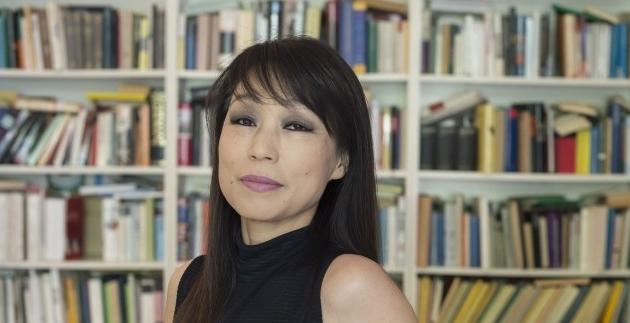
Each of the two pieces that occupied the opening portion of the San Francisco Symphony’s Oct. 7–9 concerts at Davies Hall had explicitly visual sources of inspiration. For her Tuxedo: Vasco ‘de’ Gama (2020), a painting by Jean-Michel Basquiat fired Hannah Kendall’s imagination. Unsuk Chin found the trigger for her 2013 Graffiti in the profusion of street art in cities around the world.
Rich with orchestral color and flash as they were, neither work came off as a programmatic analog or decorative orchestral scene painting. In an exciting and provocative program that partnered vital contemporary compositions by women with Beethoven’s Symphony No. 7, Music Director Esa-Pekka Salonen offered listeners a multidimensional experience of surface allure, depth, perspective, and framing social context.
Preceded by the composer’s recorded remarks, in which she referred to the complex issues of globalization and multiculturalism, Kendall’s Tuxedo, in its U.S. premiere, opened with bright shard-like phases and a fragile violin solo. The strings sent a repeated wide interval aloft. Questing and unresolved, it became a melodic and rhythmic driver for much of what followed.

As the interval was traded around the ensemble, from woodwinds to percussion to brass and back, the space between the two notes collapsed and expanded, filled in, and emptied out, sometimes over a shiny string ostinato. The potential for optimistic discovery on the one hand and futility on the other seemed to hang in gleaming balance. Such are the rewards and risks for any explorer, whether he’s venturing across the globe, like the Vasco da Gama referenced in the title, or she’s writing a piece of music, touched with a hint of the blues, that travels great distances as well — even at a mere six minutes of running time.
With a faint tremolo and furtive skittering in the strings, Graffiti made a surreptitious entrance in its San Francisco debut. Soon enough, like a nimble artist with a spray can, Chin was splashing phrases from harp to piano to a seductively brushed snare. Titled “Palimpsest,” this first of three movements conjured a beguiling transparency of sonic textures and effects. The strings swooned and swayed. A high-pitched flute grabbed attention. The cellos lolled lazily, then plucked up their courage. No sooner did a listener fix on something than it dematerialized and gave way to something else.

A large and busy percussion ensemble, which featured temple blocks, cowbells, and a thunder sheet, figured prominently in the two sections that followed — “Notturno urbano” and a cheerfully noisy “Passacaglia.” A clamor of chimes and bells conjured a midnight mood, with bassoon and bass clarinet adding their own dark admonitions.
As the orchestra mounted a game, chromatic climb out of the murk, the music moved through blurry, drifting passages suddenly intercut by rude, raw shrieks from the brass and unruly rattles from all those percussion tools. Chin’s sprawling imagination brought an overtly narrative piece to mind — Berlioz’s Symphonie Fantastique. But Graffiti was not about to be pinned to any specific story or image. What it did, right to the end, was cling to spontaneity, uncertainty and a vibrant volatility.
In the high-stakes, high-contrast Beethoven Seventh that came after intermission, Salonen offered discoveries in a familiar piece that echoed and reinforced those that had come in the first half of the evening. The values of space and amplitude, compression and expansion that Kendall and Chin employed played out in fascinating, gripping ways in the symphony.
The first movement opened out in stately tempos, lush textures, and musing, almost pictorial contemplation of individual phrases and notes. Sweetness spilled like honeyed light at the end.
After a suave and deftly woven slow movement, Salonen and the orchestra all but slashed their way through the Presto, like so many urban street artists, the music by turns angular, tense, and coarse grained. Hurtling into the Allegro, the performance ended in a propulsive but disciplined rush.
By following an eclectic season “reopening” the week before with this well-programmed and realized concert, Salonen served notice that he and the San Francisco Symphony have many and varied new paths to explore.





